New Pew chief says newspapers still looking for winning digital business model
Inexpensive, easy-to-use digital cameras and the ability to file stories via the Internet are exciting technologies that may trigger the next revolution in journalism, but, at least when it comes to newspapers offering rich media-enhanced websites augmented with video stories, no economic model has appeared that makes the business pay.
That’s the conclusion of Alan Murray, the new president of Pew Research, who reviewed the findings of the research organizations latest “State of the News Media Report” May 1 during a luncheon for media leaders at the George Washington University School of Media and Public Affairs.

Murray, who spent the past five years running the digital news operations of "The Wall Street Journal" before joining Pew, said he understands the enthusiasm for digital media. “Part of it is the digital world gives us many tools to communicate with that (digital media) audience in much more interesting ways. It’s not just news stories; it’s blogs, live blogs, rich interactive graphics, long slide shows,” he said.
However, the problem is as a percentage of total revenues, digital media revenue is still “very, very small” and does not make up for the continuing rapid decline in core newspaper revenues, said Murray.
Transplanting the traditional ad model to the digital world hasn’t been lucrative for newspapers because “what we’ve discovered is at the end of the day, most advertisers really don’t give a damn about journalism or news. They just care about getting to those people (the audience), and if they have other ways to do it that are cheaper, they will do it,” he said.
One need look no further than what is happening in digital advertising to see that Google and Facebook take the biggest pieces of the pie and neither produces news or journalism in the traditional sense.
As a consequence, there are about 30 percent fewer reporters in the workforce actually covering news than there were at the peak of newsroom staffing, said Murray. The impact of fewer reporters is clear. For big national stories, such as the Boston Marathon bombing, there are many reporters and resources deployed, but for smaller stories there’s a dearth of journalists, said Murray.
The professional video industry's #1 source for news, trends and product and tech information. Sign up below.
“If you go to any state capital in this country, I would encourage you to walk into the State House and ask where the press room is,” said Murray to illustrate his point. “Go in and see how many of the desks are occupied. The gaps in coverage are pretty apparent and not hard to find.”
Not all of findings in the latest Pew report on the state of the media are bad, however. In Murray’s view, the most encouraging finding was that people are actually consuming more news. The convenience of accessing news with mobile phones, media tablets and other devices is largely responsible for the increase.
Pew’s research shows 31 percent of the people say they spend more time with news than they used to; 31 percent turn to new sources for news; and 43 percent say they are adding to the news they consume every day, he said.
There’s also been a small but noticeable uptick in digital revenues, and pay walls are emerging as an important strategy for newspapers looking for the digital golden egg. According to Murray, 450 newspapers now have added pay walls in the past three years or have plans to do so this year.
Murray’s presentation, “Fool’s Gold? Journalism in the Digital Age,” also featured a montage of video stories filed from around the world by "Wall Street Journal" reporters using nothing more than an iPhone, a microphone and the Internet for contribution. The video stories, which appeared online, are a harbinger of the next big advance in journalism, he said.
“The increasing quality of the tools, the decline in the cost of the tools that will allow reporters in the field to shoot video and file video over the Internet, I think is bringing journalism on the edge of another new revolution,” said Murray.
